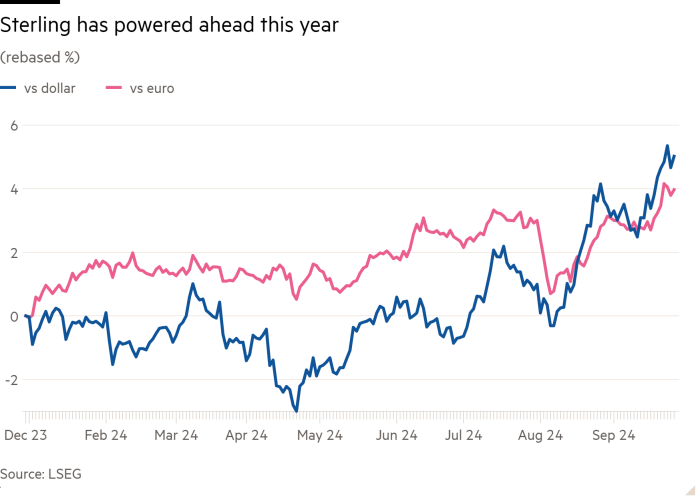
Unlock the Editor’s Digest for free
Roula Khalaf, Editor of the FT, selects her favourite stories in this weekly newsletter.
Sterling is set to make further gains, even after a blistering recent run, thanks to a buoyant UK economy and the Bank of England’s caution on cutting interest rates, say investment banks.
Bank of America and Barclays expect the pound, which is at present trading around $1.3421, to rise to $1.35 by the end of the year. Goldman Sachs has a price target of $1.40 over the next 12 months.
Sterling has been the best performing of the G10 group of most heavily traded currencies this year, gaining more than 5 per cent against the dollar and 4 per cent against the euro. It has rallied strongly since late April, when it briefly dropped below $1.23.
On a trade-weighted basis the pound is at its highest level since the UK’s 2016 vote to leave the EU, and is only about 2 per cent lower than on the eve of the referendum.
The gains have been fuelled by expectations that UK interest rates will remain higher than in other countries, owing to stubborn inflation in services and an economy that has been surprisingly resilient.
“The big picture remains that the UK has performed better than expected, the BoE is easing more gradually than other central banks and we might get an improvement in our relationship with [the] EU,” said Athanasios Vamvakidis, global head of G10 FX strategy at BofA.
The banks’ bullish outlook comes as sterling rose 0.7 per cent against the dollar on Thursday, taking it to a new two-and-a-half year high, and added a further 0.1 per cent on Friday.
“We have been inching higher our sterling target for a few months, reflecting our bullish sterling view,” said Kamakshya Trivedi, head of global foreign exchange at Goldman.

While investors have been increasing their bets on central bank rate cuts in recent months amid fears of a slowdown in the US economy, the shifts have been much bigger in the US and Eurozone than in the UK.
The Federal Reserve and European Central Bank have each delivered half a percentage point of cuts so far this year, with about 1.4 and 1 percentage points more of cuts priced in by March next year respectively.
The BoE meanwhile has only lowered rates by a quarter-point in August, with just three or four more such rate reductions expected over the next six months.
The central bank is reluctant to lower rates quickly and risk a flare-up of inflation. While headline inflation remained close to target at 2.2 per cent in August, services inflation — closely watched by the BoE as a sign of underlying price pressures — rose to 5.6 per cent.
“Inflation is moving in the right direction but is still higher than the eurozone and US,” said Vamvakidis. “It suggests BoE will ease at a slower pace.”
Meanwhile, UK private sector activity grew more than expected in August to its fastest pace in four months, while the OECD on Wednesday forecast the UK would have one of the fastest growing among the world’s biggest economies.
The OECD expects UK GDP to expand by 1.2 per cent in 2024 and 1 per cent in 2025. The Paris-based organisation predicted the US economy would grow 2.6 per cent this year while Germany’s will lag at 0.1 per cent.
Lefteris Farmakis, an FX strategist at Barclays, said the relatively resilient UK economy and slow pace of disinflation was part of the reason for the bank’s bullish sterling view.
He also said the Labour government’s intention to pursue a closer EU-UK relationship could “operate as a positive supply shock that further compresses the pound’s Brexit premium”.
While a buoyant currency may be seen as an endorsement of the UK’s economic performance this year, worries are also growing about the poor state of the public finances, ahead of the new Labour government’s first budget on October 30.
However, Barclays’ Farmakis believes that this should not present a long term challenge to growth, adding that “the possibility for perceived anti-growth measures should at worst be temporary”.
Some investors think sterling could soon run out of steam. “I have been generally positive [on sterling] over the past six months but now we are getting to levels which are making me a bit nervous,” said Geoff Yu, foreign exchange strategist at BNY.
Michael Metcalfe, head of macro strategy at State Street, one of the world’s largest custodian banks, said asset managers in aggregate were “neutral” on sterling. “We think this most likely reflects doubts that the BoE’s easing cycle will be shallower than the Fed’s given the US economy’s better growth outlook,” he said.